Foot Oligodactyly as the Main Dysplasia in Children
- PMID: 36925980
- PMCID: PMC10013307
- DOI: 10.7759/cureus.34896
Foot Oligodactyly as the Main Dysplasia in Children
Abstract
Introduction Foot oligodactyly is usually associated with fibular insufficiency or cleft foot syndrome. A foot with a reduced number of rays may occasionally have an isolated dysplasia. Methods We reviewed the clinical notes and X-rays of six children with oligodactyly, having a normal development of the tibia and fibula. Clinical evaluation recorded the plantigrade or deviated foot, appropriate shoe wear, and aesthetic presentation of barefoot children. Radiological examination revealed missing or hypoplastic bones in the foot, the presence of other deformities, and leg length discrepancy (LLD) of the affected limb. Results On clinical evaluation, all children except one had a plantigrade foot with normal shoe wear; the lesion was not spotted in three of them unless informed of the presence of the dysplasia. Radiological examination in four of them revealed the absence or hypoplasia of the navicular, with a normal shape of the first metatarsal. Calcaneocuboid joints were normal in five of them; LLD was the main problem in three children. The girl with bilateral oligodactyly presented as a normal child. Conclusion Oligodactyly may present as an isolated dysplasia. LLD in these patients, which is less severe than in children with fibular or tibial insufficiency, is the main issue that requires surgical management in later life. Prenatal diagnosis of oligodactyly as an isolated dysplasia is an important feature for appropriate counseling of parents.
Keywords: absent foot rays; fibular hemimelia; foot dysplasia; leg length discrepancy; oligodactyly.
Copyright © 2023, Laliotis et al.
Conflict of interest statement
The authors have declared that no competing interests exist.
Figures


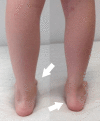
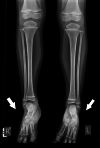


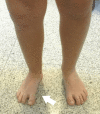



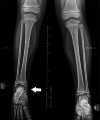
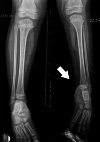
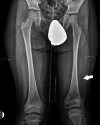
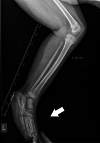





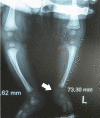
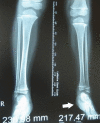
References
-
- Congenital deficiency of the fibula. Achterman C, Kalamchi A. J Bone Joint Surg Br. 1979;61-B:133–137. - PubMed
-
- Postaxial hypoplasia of the lower extremity. Stevens PM, Arms D. https://pubmed.ncbi.nlm.nih.gov/10739276/ J Pediatr Orthop. 2000;20:166–172. - PubMed
-
- Fibular hypoplasia with absent lateral rays of the foot. Maffulli N, Fixsen JA. J Bone Joint Surg Br. 1991;73:1002–1004. - PubMed
-
- Surgical treatment of the cleft foot. Tani Y, Ikuta Y, Ishida O. Plast Reconstr Surg. 2000;105:1997–2002. - PubMed
LinkOut - more resources
Full Text Sources
